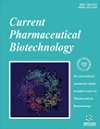- Home
- A-Z Publications
- Current Pharmaceutical Biotechnology
- Previous Issues
- Volume 23, Issue 10, 2022
Current Pharmaceutical Biotechnology - Volume 23, Issue 10, 2022
Volume 23, Issue 10, 2022
-
-
Zinc Phosphate Nanoparticles: A Review on Physical, Chemical, and Biological Synthesis and their Applications
More LessAuthors: Mona Sadeghi-Aghbash and Mostafa RahimnejadNanotechnology is considered one of the emerging fields of science that has influenced diverse applications, including food, biomedicine, and cosmetics. The production and usage of materials with nanoscale dimensions like nanoparticles are attractive parts of nanotechnology. Among different nanoparticles, zinc phosphate nanoparticles have attracted attention due to their biocompatibility, biosafety, non-toxicity, and Read More
-
-
-
Bacterial Proteomics and its Application in Pathogenesis Studies
More LessBacteria build their structures by implementing several macromolecules such as proteins, polysaccharides, phospholipids, and nucleic acids, which preserve their lives and play an essential role in their pathogenesis. There are two genomic and proteomic methods to study various macromolecules of bacteria, which are complementary methods and provide comprehensive information. Proteomic approaches are us Read More
-
-
-
Escherichia coli and Colorectal Cancer: Unfolding the Enigmatic Relationship
More LessColorectal cancer (CRC) is one of the deadliest cancers in the world. Specific strains of intestinal Escherichia coli (E. coli) may influence the initiation and development of CRC by exploiting virulence factors and inflammatory pathways. Mucosa-associated E. coli strains are more prevalent in CRC biopsies in comparison to healthy controls. Moreover, these strains can survive and replicate within macrophages and induce a pro-infla Read More
-
-
-
Herbal Medicine for the Management of Laxative Activity
More LessConstipation is one of the most common and prevalent chronic gastrointestinal conditions across the globe that is treated or managed through various methods. Laxatives are used for the treatment or management of chronic/acute constipation. But due to the adverse effects associated with these laxatives, herbal foods should be considered as alternative therapies for constipation. In this review, the laxative potential of Read More
-
-
-
In vitro Antioxidant and Antimicrobial Studies of Ethanolic Plant Extracts of P. granatum, O. stamineus, A. bilimbi, M. nigra, and E. longifolia
More LessAuthors: Essam A. Makky, Manaf AlMatar, Mahmood H. Mahmood, Khoo X. Wen and Tan B. G. QiBackground: Acne is a serious skin problem that affects mostly adolescents. The topical and systematic therapies are effective but could lead to several side effects and the emergence of antibacterial resistance of the acne-causing bacteria. Plant resources have been used as traditional medicine for centuries and can be the alternative therapies for acne treatment. Antioxidants are compounds that can prevent or delay t Read More
-
Volumes & issues
-
Volume 26 (2025)
-
Volume 25 (2024)
-
Volume 24 (2023)
-
Volume 23 (2022)
-
Volume 22 (2021)
-
Volume 21 (2020)
-
Volume 20 (2019)
-
Volume 19 (2018)
-
Volume 18 (2017)
-
Volume 17 (2016)
-
Volume 16 (2015)
-
Volume 15 (2014)
-
Volume 14 (2013)
-
Volume 13 (2012)
-
Volume 12 (2011)
-
Volume 11 (2010)
-
Volume 10 (2009)
-
Volume 9 (2008)
-
Volume 8 (2007)
-
Volume 7 (2006)
-
Volume 6 (2005)
-
Volume 5 (2004)
-
Volume 4 (2003)
-
Volume 3 (2002)
-
Volume 2 (2001)
-
Volume 1 (2000)
Most Read This Month
Article
content/journals/cpb
Journal
10
5
false
en


